If you’re looking for a way to nourish your body and boost your glow, a retinol carrot salad is a perfect start. Packed with beta-carotene that transforms into Vitamin A (retinol), this vibrant dish is more than just crunchy—it’s functional food. Great for skin, eyes, and immunity, this easy recipe brings flavor and freshness to your table. Whether served solo or as a colorful side, retinol carrot salad offers a delicious way to eat for wellness. Today, we’ll explore the story behind it, its glow-worthy benefits, and how you can make it your own in just minutes.
The Story & The Superfood Start
Why Carrots Were Always on My Table
When I was little, Grandma Mabel would hand me a carrot fresh from the Kentucky garden and say, “Eat this, it’s sunshine for your skin.” It wasn’t until years later, stirring herbs and honey in my Asheville kitchen, that I truly understood what she meant. That’s how this retinol carrot salad came to life—born of memory, nature, and a little homegrown know-how.
After a long hike in the Blue Ridge, my body craved something raw, crunchy, and skin-loving. I reached for carrots, my favorite root. Grated, tossed with herbs, apple cider vinegar, and sunflower seeds, this salad turned into a glow-up on a plate. With every bite, it reminded me of Mabel’s “feel-good food”—the kind that’s simple, healing, and earthy.
What makes this retinol carrot salad special is the concentration of beta-carotene. Your body turns that into retinol, a form of Vitamin A, helping to regenerate cells, strengthen vision, and support immune function. Unlike synthetic supplements, the retinol you get from carrots is nature-made and easy to absorb—especially when combined with healthy fats like olive oil or tahini.
And it’s more than just beautiful food—it’s practical. This retinol carrot salad keeps well in the fridge for days and pairs easily with proteins or whole grains.
The Secret Behind the Glow: Retinol and Beta-Carotene
Retinol carrot salad is a powerhouse because it centers on raw carrots—one of the richest sources of beta-carotene. That’s the orange pigment your body uses to create retinol. And this transformation doesn’t just impact your appearance; it plays a role in skin repair, hormone regulation, and even your ability to fight off infections.
This salad is best eaten raw to preserve those antioxidants. Combined with seeds and a bit of oil, the body soaks in every bit of that glow-enhancing goodness. It’s proof that food can be simple and still profoundly healing.
Looking to pair this skin-loving salad with a healing beverage? Try this ginger tea for nausea that offers quick relief or sip on a calming sleepy girl mocktail for better sleep. Both work wonderfully with plant-based meals.
Health Benefits of Retinol Carrot Salad
Vitamin A Powerhouse: Why It Matters
When it comes to nourishing your body from the inside out, few ingredients rival what carrots offer. At the heart of every vibrant retinol carrot salad is beta-carotene, the pigment that makes carrots orange—and a nutritional powerhouse your body converts into retinol, also known as Vitamin A.
So, are carrots good for retinol? Absolutely. One medium carrot contains about 509 micrograms of retinol activity equivalents (RAE)—more than 50% of your daily requirement. Eat two or three carrots in a salad and you’re supporting your skin, vision, and immune system without ever opening a supplement bottle.
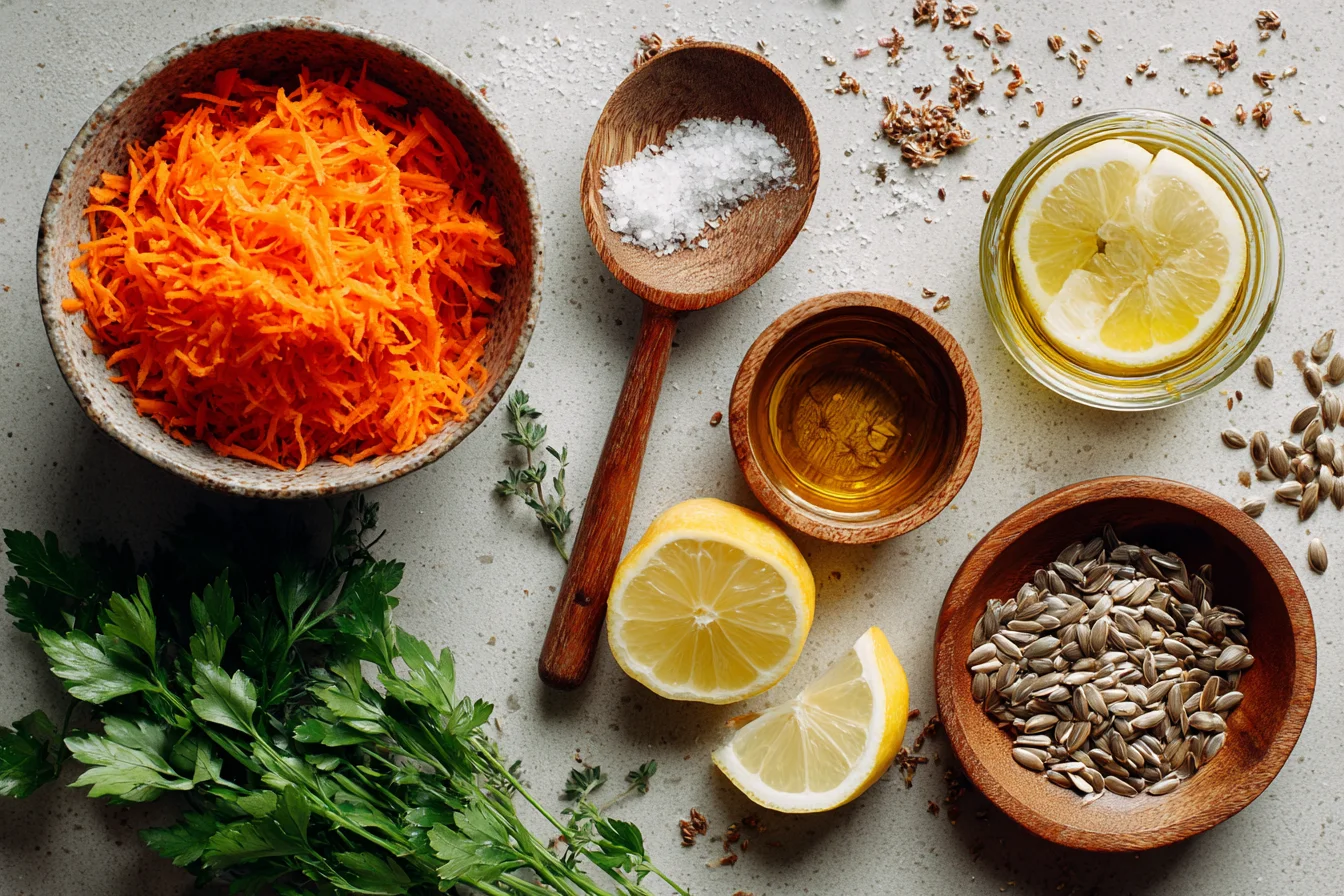
Retinol promotes cell regeneration, which means healthier skin turnover and stronger barriers against dryness, pollution, and inflammation. That’s why I call this dish my “edible skincare.” And since fat-soluble vitamins like A need healthy fats for absorption, pairing it with olive oil, tahini, or even avocado maximizes the benefits.
If you’re chasing wellness through food, adding a retinol carrot salad to your weekly menu is an easy win. It’s low in calories, high in fiber, and deeply hydrating—perfect for hot days, detox meals, or just when your body says, “feed me something fresh.”
Skin, Sight, and Strength: The Wellness Trifecta
There’s a reason carrot salad is considered a skin-supportive favorite. Retinol boosts collagen production, smooths texture, and defends against UV damage from the inside. I started making this salad regularly after a stretch of dry winter skin and noticed a visible difference within weeks—brighter tone, less flakiness, more glow.
But beyond beauty, retinol carrot salad plays a major role in protecting vision. Beta-carotene helps maintain the surface of the eye and prevents age-related macular degeneration. In traditional herbal practice, carrots are often recommended for tired or strained eyes—and science backs that up.
What’s more, Vitamin A supports your immune system by maintaining mucous barriers and aiding white blood cell production. That means fewer sick days and better defense year-round. If you’re navigating seasonal shifts or healing from fatigue, start here. Then pair it with a zinc-rich lentil stew for a nutrient-dense combo.
And yes, carrot salad is good for your skin—but it’s also good for your soul. Its bright colors, crisp texture, and sweet-earthy flavor awaken your senses and remind you that eating healthy doesn’t have to be boring. It can be beautiful, healing, and deeply satisfying.
How to Make the Ultimate Retinol Carrot Salad
Fresh, Raw, or Roasted: Choosing the Right Carrots
Not all carrots are created equal, especially when it comes to making a truly nourishing retinol carrot salad. The fresher the carrot, the higher the beta-carotene content—which means more retinol for your body. I always go for local, organic carrots when I can. If they still have the greens attached, even better—that’s a sure sign of freshness.
For this salad, raw carrots work best. Grating them brings out their natural sweetness and makes them easier to digest while keeping all that vitamin goodness intact. Roasted carrots are delicious, too, but beta-carotene levels can drop with prolonged heat exposure.
If you’re using heirloom varieties like purple or yellow carrots, know that they offer different antioxidants and flavor profiles. Purple ones are rich in anthocyanins, while yellow have a milder taste. For the deepest retinol benefits, stick to classic orange.
Before you grate or shave, give them a good scrub but skip the peel if they’re fresh—there’s nutrition in that skin. And if you’re short on time, a food processor can do the hard work for you in seconds. Then just toss and enjoy.
Dressing It Up Naturally: Herbal and Zesty Add-ins
Once your carrots are shredded, it’s time to bring the salad to life. A well-balanced retinol carrot salad needs brightness, texture, and depth—and that’s where dressing and mix-ins make magic.
I like to start with a base of apple cider vinegar, fresh lemon juice, or even orange zest. These acids not only awaken flavor but help preserve the salad for a couple of days. For healthy fats that aid in retinol absorption, drizzle in extra-virgin olive oil or stir in a spoonful of tahini.
Then come the herbs: chopped flat-leaf parsley, cilantro, or dill add freshness and extra antioxidants. I often reach for parsley straight from my garden—it pairs beautifully with the natural sweetness of carrots.
For texture and added nutrients, toss in toasted sunflower seeds or pumpkin seeds. Craving creaminess? Add a few chunks of avocado.
Here’s my go-to base mix:
- Grated carrots (3–4 medium)
- 1 tbsp apple cider vinegar
- 1 tbsp olive oil
- 1 tsp honey
- 2 tbsp chopped parsley
- Pinch of sea salt & cracked pepper
- Optional: sunflower seeds, raisins, or feta
Once everything is combined, let it marinate for at least 15 minutes. The flavors deepen, and the carrots soften just slightly—perfect for spooning next to your rosemary roasted chicken or wrapping in a warm grain bowl.
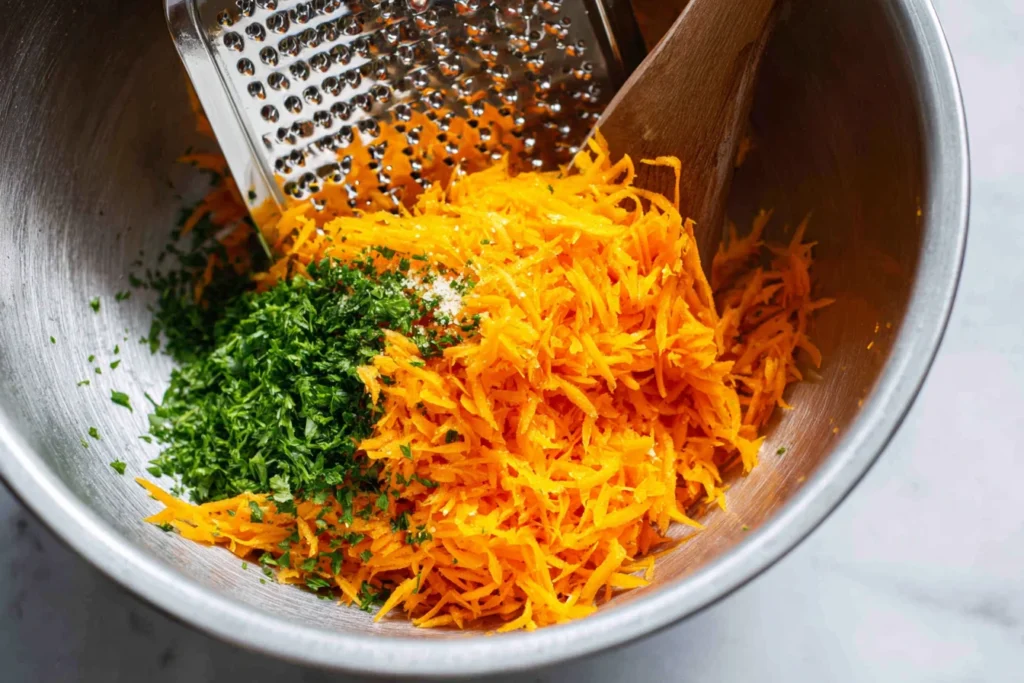
Craving even more vitamin-packed nourishment? This watermelon strawberry juice and a cozy mug of gut-healing bone broth make amazing companions to your carrot salad.
Customizations and Serving Ideas
Add Proteins and Grains for a Full Meal
One of the things I love most about retinol carrot salad is how versatile it is. With a few smart additions, you can turn it from a light side dish into a filling, nourishing main.
For plant-based protein, try tossing in chickpeas, lentils, or cubes of baked tofu. They soak up the dressing beautifully and add staying power without overwhelming the delicate carrot flavor. Crumbled feta or goat cheese brings richness and calcium, while grilled chicken breast or wild salmon make it a protein-packed lunch or dinner.
Want to bulk it out? Serve the salad over cooked quinoa, farro, or brown rice. These whole grains add fiber and minerals, and they balance the natural sweetness of the carrots with a hearty, nutty base. This combo is a staple in my home when I need something comforting but clean.
I often pair this with my lemon tahini chickpea patties or serve it as a topping for cold soba noodle bowls on warmer days. It layers well, travels well, and holds its own as the star of any meal.
And yes, it even holds up in lunchboxes—just pack the dressing separately or mix everything right before eating to keep it vibrant.
Perfect Pairings: What to Serve With It
This salad plays well with nearly everything. Its brightness cuts through richer mains, and its crunch offers balance to softer textures. I love serving retinol carrot salad alongside roasted dishes, grain bowls, and even soups.
For family dinners, try plating it beside maple thyme sweet potatoes or our beloved herb-roasted turkey thighs. The contrast between warm, savory comfort food and this cool, zesty salad is simply satisfying.
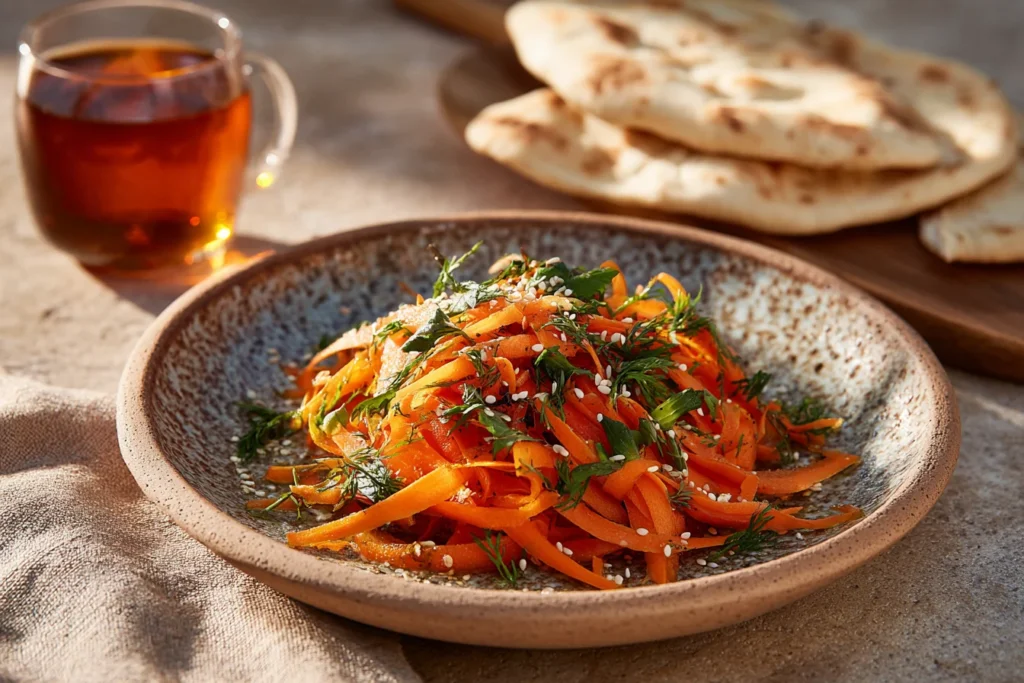
Looking for picnic fare or potluck ideas? This salad travels beautifully. It doesn’t wilt, and the flavors deepen as it sits—just like a good slaw. I’ve brought it to more than one neighborhood cookout and watched the bowl empty faster than the deviled eggs.
You can also serve it in wraps or pita sandwiches. Add a smear of hummus, some greens, and a handful of this salad for a fresh, functional handheld lunch. If you’re in a mood for cozy yet vibrant meals, check out our stuffed lentil wraps for inspiration.
Whatever way you serve it, one thing’s certain: this salad fits in anywhere, whether you’re nourishing your glow or feeding your people.
FAQs
Is carrot salad a good source of retinol?
Yes! Carrot salad is an excellent natural source of retinol, specifically in the form of beta-carotene, which the body converts into retinol (Vitamin A). This makes it a gentle, plant-based way to boost your vitamin A intake without synthetic supplements.
How to make retinol salad?
Start by grating fresh orange carrots, then dress them with olive oil (for absorption), a splash of apple cider vinegar, lemon juice, herbs like parsley, and optional toppings like seeds or nuts. Let it marinate and enjoy. This is the core of a nutrient-rich retinol carrot salad.
How much retinol is in one carrot?
One medium raw carrot contains around 509 mcg RAE (Retinol Activity Equivalents), which is over 50% of your daily Vitamin A requirement. In a typical serving of this salad, you could easily get over 100% of your needs.
Is carrot salad good for your skin?
Absolutely. The beta-carotene in carrots converts to retinol, which supports skin renewal, elasticity, and glow. Eating retinol carrot salad regularly can help protect your skin from dryness, UV damage, and early signs of aging.
Conclusion
In my kitchen, food isn’t just about flavor—it’s about function. And this retinol carrot salad checks every box. It’s bright, crunchy, and easy to make, but more than that, it fuels your body with one of the most important vitamins for skin, immunity, and vision: retinol.
Whether you’re after a quick side, a meal-prep star, or a skin-nourishing staple, this salad delivers every time. It honors simplicity while offering real nourishment—and that’s the kind of cooking I grew up on. From Grandma Mabel’s hands to your table, this is a dish that heals, glows, and gives back.
So grate those carrots, pour a little love (and olive oil), and let nature take care of the rest. And if you find yourself glowing a little more tomorrow morning—you’ll know exactly why.
Discover other healthy recipes on our facebook page.
Looking for herbal harmony? Brew a pot of chrysanthemum tea with goji berries or whip up this naturally sweet and tangy ginger switchel to round out your wellness meal.
Print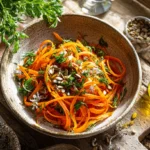
Easy Retinol Carrot Salad : the recipe for Boosting Your Skin
- Prep Time: 10 minutes
- Cook Time: 0 minutes
- Total Time: 10 minutes
- Yield: 2 servings 1x
- Category: Salads
- Method: No-Cook
- Cuisine: Healthy
- Diet: Vegetarian
Description
This vibrant carrot salad is loaded with beta-carotene, healthy fats, and flavor. A perfect side or light main dish that helps boost your retinol intake naturally.
Ingredients
4 medium carrots, peeled and grated or ribboned
2 tablespoons apple cider vinegar
2 tablespoons extra virgin olive oil
1 tablespoon lemon juice
1 tablespoon fresh parsley, chopped
1 tablespoon sunflower seeds
Salt and pepper, to taste
Instructions
1. Peel and grate or ribbon the carrots using a grater or vegetable peeler.
2. In a mixing bowl, whisk together apple cider vinegar, olive oil, and lemon juice.
3. Add the carrots, chopped parsley, and sunflower seeds.
4. Toss everything well to combine.
5. Season with salt and pepper.
6. Let rest 10 minutes before serving for maximum flavor.
Notes
Add raisins or feta for extra flavor.
Pair with chickpeas or grilled chicken for a full meal.
Keeps in the fridge up to 3 days.
For maximum Vitamin A absorption, serve with olive oil or tahini.
Nutrition
- Serving Size: 1 bowl
- Calories: 120
- Sugar: 6g
- Sodium: 150mg
- Fat: 7g
- Saturated Fat: 1g
- Unsaturated Fat: 6g
- Trans Fat: 0g
- Carbohydrates: 13g
- Fiber: 4g
- Protein: 2g
- Cholesterol: 0mg
Keywords: retinol carrot salad, vitamin A salad, beta carotene salad
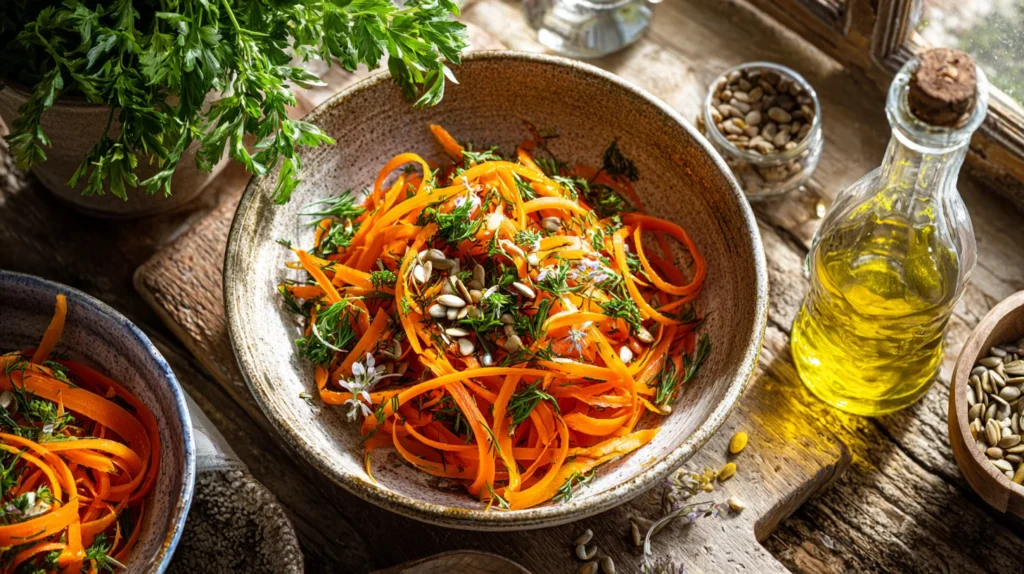
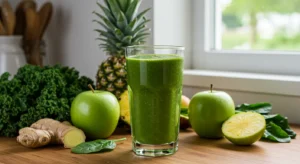


10 thoughts on “Easy Retinol Carrot Salad : the recipe for Boosting Your Skin”